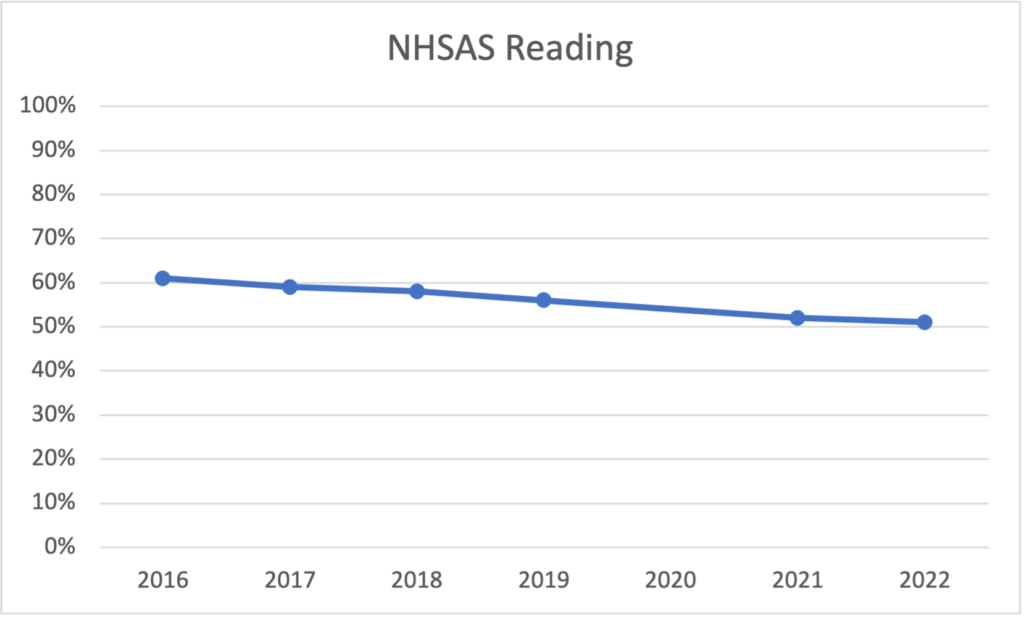The opening article of this series, published in the September 9 edition of the Eagle Times and in Granite Grok, examined test results from the Croydon Village School in light of comments made by its principal, Nicole Lackie, who also shared her belief that schools do not know how to teach reading.
The conventional wisdom says that the pandemic shutdowns affected student performance in public schools. In Croydon, this proved not to be the case. Now, we take an in-depth look at what happened to student achievement at the state level before and after the pandemic shutdowns on the New Hampshire Student Assessment System (NHSAS) and the National Assessment of Educational Progress test.
The NHSAS
The New Hampshire Student Assessment System (NHSAS) is administered yearly to students attending traditional public and charter schools in grades 3 through 8. The SAT is administered to NH students in grade 11; it’s free, and it’s required, whether you are college-bound or not.
Despite RSA 193-H:2 requiring public schools to have “all pupils at the proficient level or above on the statewide assessment,” no school in New Hampshire has achieved this result or even come close. One might ask what purpose is served by these tests or this statute, but that is not the purpose of this review.
The New Hampshire Department of Education (NHEd) has a record of statewide assessment data since it started using the NHSAS in 2016. Tests were not administered in 2020 because of the pandemic shutdowns.
In what follows, we use the phrase “the score” to refer to “the percentage of students performing at or above the most basic level of proficiency” on any given test.
Summary of NHSAS Scores Since 2016
The NHSAS Reading chart below shows the percentage of students scoring proficient or above in reading on the state standardized tests in grades 3-8 and 11 from 2016 through 2022.
Reading scores have been dropping linearly since 2016, when nearly 40%, 4 out of 10 students, performed below grade level.
In 2022, the number of students scoring proficient had fallen to about 50%. There is no evidence of an extra drop in reading performance because of the shutdown. In other words, reading scores seem to be just where they would have been anyway, had the shutdown never happened. But let’s break that down more by looking at student performance in each grade.
We’ll start with students who were in kindergarten in 2018 and see how they performed through 2023. This group was in 2nd grade during the 2020 shutdown. They started testing in 2021 as 3rd graders, where 44% of them were proficient in reading. In 2023, their 5th grade scores showed that 54% were proficient. These numbers seem to disprove the prevailing narrative.
Similar to the 2018 kindergarten chart, each group of bars in the Reading Group Progression chart (below) shows how the different sets of students performed in the 6-year period from 2018 to 2023.
Those same kindergarten students are shown in the first set of bars on the left. Students who were in 1st, 2nd or 3rd grade in 2018 all showed about the same levels of proficiency throughout their testing. Around half the students are reading at grade level.
Those who were in grades 4 and 5 in 2018 showed some decline after the shutdown. These two groups of students seem to be the hardest hit by the pandemic shutdown when they were in 6th and 7th grades, respectively. Even so, about 50% of students across the board read below grade level and always have.
It seems that the pandemic has distracted us from the larger problem: that half our students have been reading below grade level for a long time.
Since one score could be questionable, let’s see how a national test measures New Hampshire student performance.
NAEP: The Nation’s Report Card
The National Assessment of Educational Progress (NAEP, pronounced “nape”) is called “The Nation’s Report Card.” Since 1969, NAEP has been designed and used by the education establishment to let everyone know how well the United States is educating its children. They report results for each state for grades 4 and 8.
According to this test, New Hampshire is near the top of the United States.
NAEP scores in New Hampshire tell a different story than the NHSAS and SAT scores. The NAEP Reading chart shows that scores for grade 4 had been rising (ever so slightly) since 1998 until they dropped in 2017, which was well before the shutdown. The grade 8 scores also started dropping after 2017.
What the data shows is that even when scores were at their highest, fewer than half of NH students have been reading at grade level since at least 1998.
Again, we should clearly state that all the NAEP scores are low. They show that even at their high in 2015, only 45% of New Hampshire grade 8 students and only 46% of students in grade 4 were proficient in reading.
Conclusion
The narrative that the COVID pandemic shutdowns made things worse academically for public schools is not supported by New Hampshire’s data. Reading scores were decreasing before the pandemic started.
More than half of the kids in public schools are performing below grade level in reading. This has been the case despite regular changes to pedagogy, curriculum, technology, funding, and other efforts to improve schools.
Perhaps other approaches should be considered, for example: Organizing students into groups at the same academic levels, using technology to help students learn at their own level and at their own pace, or only allowing students to attend school when they are developmentally ready to read.
Next, we will look at how Vermont’s students may have been affected by the pandemic shutdown, according to its state assessments and the NAEP test.
This article originally appeared in the Eagle Times on September 12, 2023. It has been slightly edited.




